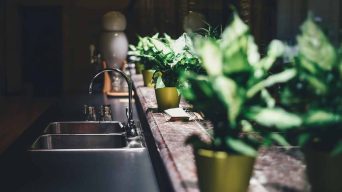Keeping your indoor plant leaves clean and shiny it’s important not just for aesthetical reasons.
A plant’s leaves are how the plant absorbs sunlight, which it uses for energy.
The shinier the leaves, the more light they can reflect and therefore the more energy your plant can produce.
This article will discuss how to make indoor plant leaves shiny.
There are a few different methods that you can use, and we will cover them all.
So whether your plants are looking a little dull, or you want to prevent them from looking dull in the future, read on for how to make indoor plant leaves shiny.
Why Are Plant Leaves Shiny?
The first step to making your plant leaves shiny is understanding why they need to be shiny in the first place.
The cells on the surface of a leaf (called the epidermis) are filled with a layer of liquid wax.
The wax acts as a barrier to prevent water from evaporating from the plant leaf and protect it from damage and pests.
The water left on the leaf then reflects light, making the leaf look shiny.
The epidermis also contains tiny pores that allow the plant to breathe.
When these pores become clogged, the leaf can’t get the oxygen it needs and starts to turn brown and dull.
Dirty leaves can lead to health problems for plants, so it’s essential to keep them clean.
Clean plant leaves are important for plant health, aesthetics, and energy production.
Why Do Plant Leaves Lose Their Shine?
Indoor plants are susceptible to a number of factors that can cause their leaves to lose their shine. These include:
- Excess dust, dirt, and debris: Dust and dirt can build up on leaves, resulting in a dull appearance.
- Lack of humidity: Dry air can cause indoor plants to lose moisture, making their leaves appear dull and lifeless. To increase the humidity around your plants, you can use a humidifier or place them on a pebble tray.
- Poor nutrition: If your plants are not getting the nutrients they need, their leaves will become yellow or brown and eventually fall off.
- Pest infestation: Insects or other pests can damage leaves, causing them to appear dull or discolored.
- Damage from chemicals: Chemicals such as cleaners, aerosols, and pesticides can damage leaves and cause them to lose their shine.
- Plants produce less oil: As plants age, they produce less wax, making their leaves appear dull.
- Damage by trichloroacetic acid (TCA) degradation: TCA is a common ingredient in plant sprays and can cause leaves to become dull and discolored over time.
To prevent these factors from damaging your plants, it is essential to regularly clean their leaves and provide them with the proper nutrition and care.
In addition, if you notice any pests on your plants, be sure to treat them immediately.
Is Leaf Shine Bad for Plants?
Leaf shine products are synthetic and can harm your plants if used too frequently.
These products can also damage your plants if used on leaves already stressed from too much sun, not enough water, or pests.
The chemicals in leaf shine can also be harmful to pets and children, so use them sparingly.
If you must use a leaf shine product, choose one made with natural ingredients and follow the directions on the label.
Apply the leaf shine to clean, dry leaves using a soft cloth.
Avoid getting leaf shine on your plant’s flowers, as it can damage them.
After you’ve applied the leaf shine, remove any excess from your plant’s leaves with a clean, dry cloth. This will help prevent the leaf shine from damaging your plant’s leaves.
Remember, less is more when it comes to leaf shine. Use it sparingly to avoid harming your plants.
Fortunately, there are safer ways to make your leaves look shiny.
What Can I Use To Make Plant Leaves Shine Safely?
There are some simple, safe solutions you can use to make your plant leaves shine:
- Soap and Water
- Banana Peel
- Milk and Water
- Vinegar and Water
- Baking Soda and Water
- Lemon Juice and Water
- Mineral Oil
Choose one of these safe solutions and follow the instructions below.
Soap and Water
Soap and water is the simplest and safest way to make your plant leaves shine.
Although it won’t give your leaves the same level of shine as a leaf shine product, it will still make them look healthier and more vibrant.
This method helps remove dust and dirt from your plant’s leaves.
Mix a drop of mild dish soap with water in a spray bottle and shake it to mix.
Spray the solution on your plant’s leaves and wipe them with a clean, dry cloth.
When you’re finished, rinse your plant’s leaves with clean water to remove any soap residue, and then dry them with a soft cloth.
Be sure to use a mild dish soap to avoid harming your plant’s leaves and avoid getting the solution on your plant’s flowers, as it can damage them.
Banana Peel
Banana peels are a safe, natural way to make your plant leaves shine.
The potassium in banana peels helps nourish your plants, and the oils in the peel help make their leaves shiny.
Rub a banana peel on your plant’s leaves to use this method.
Be sure to rub the banana peel on both sides of the leaves.
After you’re finished, discard the banana peel and wipe any excess oils from your plant’s leaves with a clean, dry cloth.
Milk and Water
Milk and water is another safe, natural way to make your plant leaves shine.
Milk diluted with water helps clean your plant’s leaves and make them shine.
To use this method, mix one-part milk with two parts water in a spray bottle and shake it to mix.
Spray the solution on your plant’s leaves and wipe them with a clean, dry cloth.
When you’re finished, rinse your plant’s leaves with clean water to remove any milk residue, and then dry them with a soft cloth.
Milk also helps treat plants that have powdery mildew as it’s a natural fungicide.
Vinegar and Water
Very diluted vinegar-water solutions can be used to cleanse and shine the leaves of your indoor plants.
To make a vinegar-water solution, mix one-part vinegar with ten parts water.
Use a soft cloth to wipe down the plant leaves with the mixture, being careful not to soak them.
Rinse the leaves with clear water afterward. Vinegar is acidic, so be sure to rinse thoroughly. You don’t want to harm your plants!
Baking Soda and Water
Another option for cleansing and shining houseplant leaves is baking soda water.
To make a baking soda-water solution, mix one tablespoon of baking soda with two cups of water.
Use a soft cloth to wipe down the plant leaves with the mixture, being careful not to soak them.
Rinse the leaves with clean water afterward.
This solution is best used on plants with tough leaves, as it can be harsh on delicate ones.
Lemon Juice and Water
If you’re looking for a natural way to make your houseplant leaves shine, lemon juice is a good option.
To make a lemon juice-water solution, mix one-part lemon juice with two parts water.
Use a clean cloth to wipe down your plant’s leaves with the solution.
Rinse the plant with clean water after you’ve wiped it down with the lemon juice-water solution.
Mineral Oil
If you want to give your plant leaves a high level of shine, you can use mineral oil.
To use this method, simply apply a small amount of mineral oil to a soft cloth and wipe it on your plant’s leaves.
Be sure to use a small amount, as too much oil can damage your plant’s leaves.
After you’ve applied the mineral oil, buff it into the leaves with a clean, dry cloth.
You can find mineral oil at most drugstores or online.
As you can see, there are a few different ways to make your indoor plant leaves shiny.
Try out a few of these methods and see which one works best for you and your plants!
What Solutions To Avoid To Make Plant Leaves Shine
There are a few solutions that you should avoid using on your indoor plants, as they can damage their leaves.
Avoid using harsh chemicals, like bleach or ammonia. These chemicals can strip the oils from your plant’s leaves, leaving them dry and damaged.
In addition, avoid using any products that contain silicone, as this can clog your plant’s pores and prevent it from being able to breathe.
Also, don’t use hot water on your plant’s leaves. Hot water can damage the leaves, causing them to become dry and brown.
Oily solutions, such as olive oil or vegetable oil, should also be avoided.
While these solutions may make your plant’s leaves shiny, they can also clog the pores on the leaves and prevent the plant from being able to breathe.
Likewise, avoid using products that contain alcohol, as this can also damage your plant’s leaves.
How To Make Plant Leaves Shine: A Step-By-Step Guide
Now that you know what solutions to avoid, let’s look at making your indoor plant leaves shine with some safe and effective methods.
Step One: Gather Your Supplies
To get started, you’ll need a few supplies.
First, you’ll need a soft cloth. A microfiber cloth or an old t-shirt will work well.
Next, you’ll need some distilled water. You can find this at most grocery stores.
If you’re using a solution with vinegar or lemon juice, you’ll also need a spray bottle.
Finally, if you’re using mineral oil, you’ll need a small container to hold it.
Step Two: Dust The Leaves
Before you start cleaning your plant’s leaves, you need to remove any dust or dirt on them.
Use your soft cloth to dust the tops and bottoms of the leaves.
If you have a large plant, you may need a step ladder to reach the top leaves.
Be sure to be gentle, so you don’t damage the leaves.
Step Three: Clean The Leaves
Once the leaves are dusted, it’s time to start cleaning them.
If you’re using distilled water, simply wet your cloth with it and wipe down the leaves.
You may need to use a spray bottle to wet plants with large leaves.
Be sure to clean both the top and bottom of the leaves.
If you’re using a vinegar-water or lemon juice-water solution, mix it in a spray bottle and use it to wet the leaves.
After you’ve sprayed the leaves, wipe them down with your cloth.
Rinse the plant with clean water after you’re finished cleaning it.
Step Four: Apply A Shine Solution
Now that your plant’s leaves are clean, it’s time to apply a shine solution.
If you’re using soap and water, mix them in a bowl and dip your cloth into the solution.
Wring out the cloth, so it’s not dripping wet, then wipe down the leaves with it.
Rinse the plant with clean water after you’re finished.
If you’re using vinegar or lemon juice, mix them in a spray bottle and use it to mist the leaves.
Wipe the leaves down with a clean, damp cloth.
Rinse the plant with clean water after you’re finished.
If you’re using mineral oil, pour some into a small container and dip your cloth into it.
Wring out the cloth, so it’s not dripping wet, then wipe down the leaves with it.
You don’t need to rinse the plant after using this method.
Step Five: Dry The Leaves
After applying the shine solution, it’s important to dry the leaves.
Wet leaves can encourage the growth of mold and mildew, which can damage your plant.
Use a clean, dry cloth to wipe down the leaves gently.
If you’re using a fan, you can turn it on and hold the leaves in front of it to help them dry faster.
You can also set the plant in a sunny spot to allow the leaves to dry.
Once the leaves are dry, your plant is ready to enjoy!
How To Keep Plant Leaves Shiny
Indoor plants are a great way to add some life to your home, but they can also be a bit of a pain to keep looking their best.
One of the most common problems is that their leaves can get dull and lose their shine.
You can do a few things to help keep your plant leaves shiny and healthy.
- Make sure that you are watering them properly. Overwatering can lead to a build-up of minerals on the leaves, which can dull their appearance.
- Wipe the leaves down with a soft cloth or brush to remove any dust or dirt.
- Mist the leaves with water regularly. This will help keep them hydrated and prevent them from drying out and losing their shine.
- If you notice any discoloration or damage, trim off the affected leaves.
- Give them some extra light. Indoor plants can often get dull leaves if they aren’t getting enough light.
Final Thoughts
Making your indoor plant leaves shiny is a simple process that requires no special tools or products.
By keeping your plant leaves clean and shiny, you are helping to improve the overall health of your plant.
In addition, shiny leaves can help improve the appearance of your indoor space by adding a touch of natural beauty.







